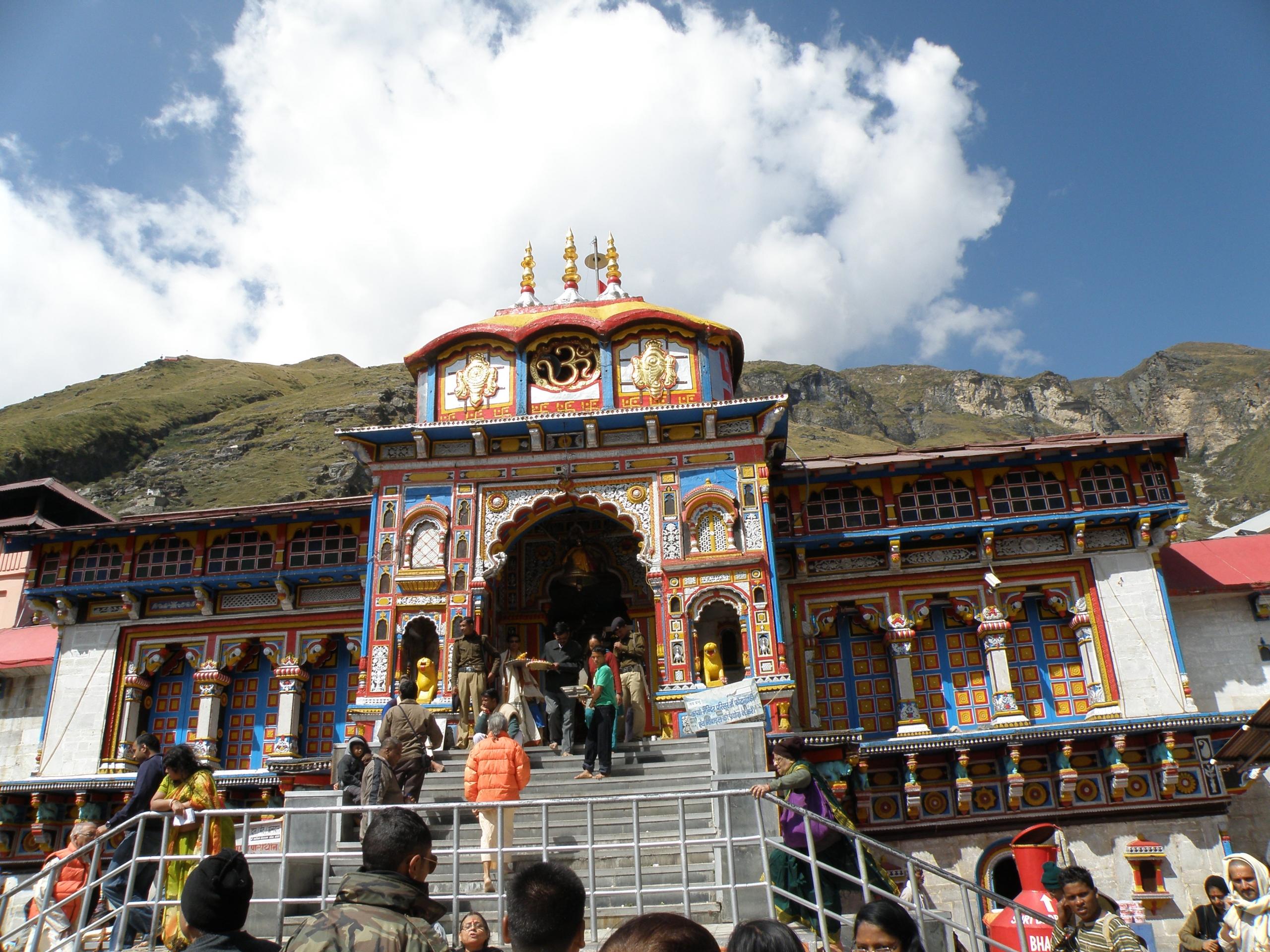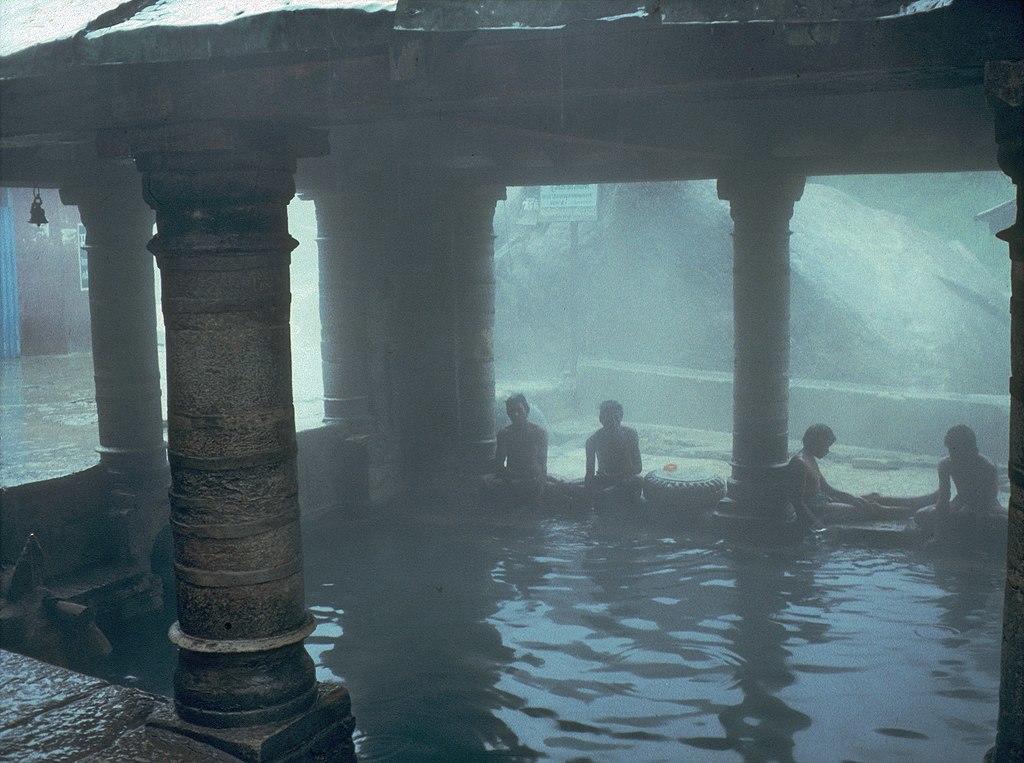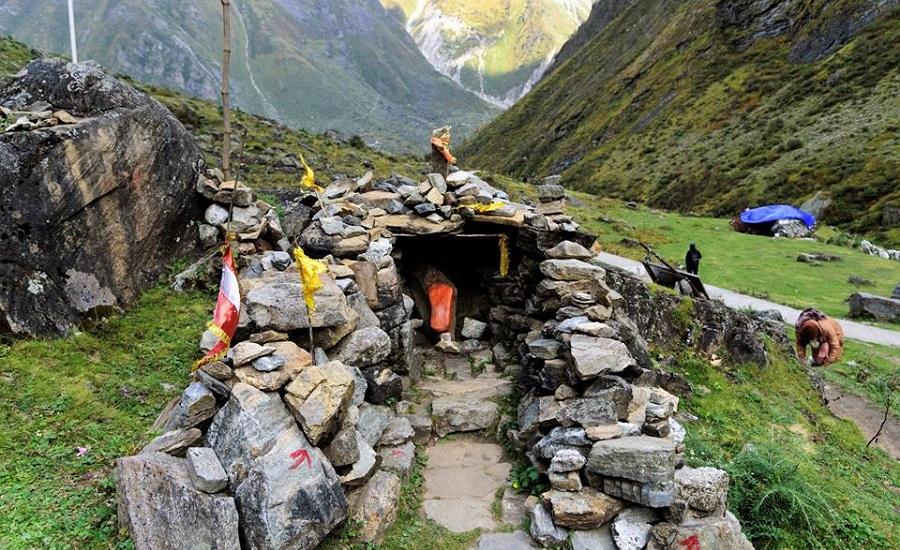Nestled within the Garhwal Himalayas in Uttarakhand, this ancient temple mentioned in the works of the Tamil Azhvars stands despite age, avalanches, earthquakes, and yearly heavy snow.
While the temple enjoys lively modern religious use, its true history is shrouded in mystery and speculation.
Several deities are present at the temple, but it is mostly a place of worship for Vishnu and several of his iterations, specifically Badrinarayan, as the namesake of the temple.
The temple also features glorious hot springs just beneath the surface, providing comfort to pilgrims and full-time residents of the area.

Where is Badrinath Temple?
Badrinath Temple (aka Badrinarayana) is in the aptly-named town of Badrinath, in Uttarakhand, India. It sits along the Alaknanda River, tucked between the Nar and Narayan peaks of the Garhwal Himalayas. The temple is high above sea level at 3,133 m (10,279 ft) elevation.
This is an incredibly hard-to-access remote area in the mountainous region and is impossible to access in the winter due to heavy snowfall and the risk of danger from avalanches. So, the temple is only open from April or May to November each year.
During the winter, pilgrims can instead worship at Yogadhyan Badri since travellers don’t have to trek through Joshimath and the narrow mountain pass that leads to Badrinath.
Badrinath Temple sits in this spot hidden from the world because it is said that Lord Vishnu meditated there long ago.

Badrinath temple is located in the Chamoli district of Uttarakhand, India | Wikipedia Commons
Getting to Badrinath Temple
Since the temple is in such a remote area of the world, it can be difficult to access. But, since it’s such a popular tourist site for pilgrims and sight-seers, access has been made as easy as possible.
There are multiple ways to get to the temple.
By Road
By road, you can take a bus from almost any populated area nearby, like Rishikesh, Haridwar, Srinagar, Dehradun, Delhi, Haryana, Rudraprayag, Chamoliand, and Chandigar. There are buses available directly from ISBT Kashmiri Gate New Delhi.
You could also drive yourself if you wanted. Alternatively, you could make your way into Joshimath and hire a driver to take you up the mountain.
By Flight
The closest airport to Badrinath is Jolly Grant Airport, which is 314 kms away. It has daily flights to and from Delhi, and there are roads connecting the airport and Badrinath. You can take a taxi to and from the airport.
By Rail
The closest railway station is Rishikesh Railway Station, which is 295 kms away. The rail service in Rishikesh connects to many major destinations around India, so you can reach Rishikesh station from all over the country. There are taxis available to take you to and from Rishikesh Railway Station.
By Helicopter
You can even book helicopter flights to take you to a helipad only 1.6 kms away from the temple. Depending on which helicopter service you use, there may be a taxi ready to take you all the way to the temple from the helipad and back.
There are a few different helicopter services to choose from, but mostly they depart from Dehradun.
This is by far the best transportation to choose if you only have a short time to make the journey!
Keep in mind that the weather is the largest determining factor in your ability to reach the area.
When Is Badrinath Temple Open for Pilgrims?
Since the location is in the Himalayas, the winter is naturally harsh and must not be underestimated.
It is unsafe and/or impossible to access the Badrinath Temple in the winter, so the temple is only open from April or May (depending on when the snow melts) to about November when the winter season begins in full, thus ending Char Dham Yatra season.
During the winter months, the worship idols are moved from Badrinath to Joshimath and to the Ukhimath of Lord Kedarnath. So, pilgrims can worship in person year-round, just not exactly in Badrinath in the winter.
"There are several sacred shrines in heaven, on earth, and in hell; but there is no shrine like Badarinath."
The Skanda Purana
The Story of Badrinath Temple
Badrinath Temple has both a religious legend and a human history, both of which are mysterious and interesting.
Lord Vishnu’s Meditation Place
One legend says that Badrinath became a holy place when Lord Vishnu decided to spend time meditating there. During that time, Lakshmi sheltered Vishnu from the elements by transforming into a Badri tree. Vishnu was grateful for the assistance, and so named the area Badrika Ashrama.
Trail of Panch Badri
Another legend says that the sons of Dharma, Nar and Narayana, wanted to expand their religious influence among the Himalayas. While seeking places to set up auspicious sites, Nar and Narayana found Dhyan Badri, Yog Bhadri, Bridha Badri, and Bhavishya Bhadri, before ending the search in Badrinath, where they found both hot and cold springs.
Creating a Holy Site
Badrinath as an important area is so ancient that nobody knows for certain who established the idea of a sacred site there. It may have become a place of importance as early as 1,500 BCE, in the Vedic Age.
What is known is that mention is made of Badrinath as a sacred place in the works of the Tamil Azhvars in the 6th to 9th centuries, before the arrival of Adi Shankaracharya.
It is believed that the original Badrinath shrine was established by Adi Shankaracharya in the 9th century (between 814 and 820) after he found a statue of Lord Badri (Vishnu) made of Saligram in the Alaknandra River. He is said to have taken the idol and installed it in a cave near the Tapt Kund, the hot springs beneath the present-day temple.
It is said that Shankaracarya’s goal in Badrinath was to push out the Buddhists in the area to keep the Hindu religion and culture alive in the region.
In the 16th century, a Garhwal King finally built the first version of the temple we see today to house the idol of Lord Badri that Shankaracharya had found so long ago. The temple was expanded in the 17th century by the Garhwals.
Through the ages, the temple has had to undergo many reconstructions due to damage caused by avalanches, and specifically the 1803 Garhwal Earthquake.

The Tapt Kund
The sulphuric hot springs located just beneath the temple are known as the Tapt Kund. Devotees who wish to visit the temple must first cleanse themselves in the hot springs, which are surrounded by stones that are regarded as being Narad, Narsingh, Varah, Garur, and Markanday per mythology.
Mata Murti Temple
Nearby, on the bank of the Alaknanda River, you can find the Mata Murti temple, which is dedicated to Mata Murti (of course). She is believed to be the mother of Lord Vishnu’s twin-brother avatar, Nar and Narayan.
Alanknanda River
This river is believed to be one of the twelve holy channels the Ganges split into when Ganga descended to Earth. Eventually, the river became a home of Lord Vishnu as Badri.
Charanpaduka
This stone monument is believed to bear the imprints of Lord Vishnu’s footprints from when he descended to Earth from Vaikunth (his home in the heavens).
Sheshnetra
On the opposite bank of the Alaknanda River, this boulder appears to have an impression of Lord Vishnu’s snake form: Shesh Nag. It appears that the boulder has the eye of Shesh Nag, and is thought to be guarding Badrinath Shrine.
Badrinath town and Temple are full of history, ancient and recent, as well as legend and myth. It’s no wonder why the temple sees millions of pilgrims each year!

Badrinath Mandir on a nice day | Photo by KRISHNA1106 on Wikimedia Commons

Badrinath Temple’s Importance in Hinduism
Of course, the temple is important in Hindu culture because it is a shrine dedicated to Lord Vishnu.
But there are many other reasons why it is considered an especially important place for Hindus, especially those devoted to Vishnu.
One of the 108 Divya Desams
Badrinath is a temple devoted to Lord Vishnu, making it a Sthalam. It is also a Divya Desam temple, which means “premium place,” fit for the highest devotion of Lord Vishnu.
There are 108 Divya Desams mentioned in the works of the Tamil Azhvars, written in the 9th and 10th centuries.
One of the 4 Dhams
Additionally, Badrinath Temple is known as being an integral part of the Char Dham and Chota Char Dham pilgrimages. There are 4 sites in these pilgrimages that must be visited in order to achieve moksha.
Other Deities at the Temple
The main focus of idols at the temple is, of course, the black stone statue of Lord Vishnu sitting in his meditative pose, padmasan. There are other deities surrounding Vishnu’s statue: Nar, Narayana, Narad, Ganesha, Garud, Lakshmi, Navadurga, Kuber, and others.
Some of the deities are other avatars of Vishnu, some are supporters and friends of Vishnu, and some are also devotees of Vishnu.
Badrinath’s Presence in Ancient Texts
Badrinath Temple is mentioned in several ancient texts including Bhagavata Purana, Skanda Purana and Mahabharata.
According to the Bhagavata Purana, “[t]here in Badrikashram the Personality of Godhead (Vishnu), in his incarnation as the sages Nar and Narayana, had been undergoing great penance since time immemorial for the welfare of all living entities”.
The Skanda Purana states that “[t]here are several sacred shrines in heaven, on earth, and in hell; but there is no shrine like Badrinath”.
The area around Badrinath Temple is also celebrated in Padma Purana as abounding in spiritual treasures.
The Mahabharata revered the holy place as the one which can give salvation to devotees arriving close to if, while in other holy places they must perform religious ceremonies.
The temple is revered in Nalayira Divya Prabandham, in 11 hymns in the 7th–9th century Vaishnava canon by Periazhwar and in 13 hymns in Thirumangai Azhwar.

The Charan Paduka of Badrinath | Source: travelogyindia.com
The Beautiful Architecture of Badrinath
The entrance to the temple grounds is marked with the colorful and imposing gate known as Singhdwar. The temple itself is about 50 feet tall, topped with a golden roof. The inside of the temple consists of three distinct sections.
The Garbha Griha
The Garbha Griha (the “sanctum sanctorum”) portion of the temple is where all the idols including the one found by Adi Shankara are housed. They are shrouded by a golden canopy.
The Darshan Mandap
The Darshan Mandap section is where the rituals are held. Here, an idol of Lord Badari Narayan is armed with Conch and Chakra in two arms in a lifted posture and two arms rested in Yogic Pose. Other deities are also present in this holy section.
The Sabha Mandap
Sabha Mandap is where pilgrims assemble.
Although the idols, architecture, carvings, and paintings in the temple are undoubtedly breathtaking, photography is prohibited inside the temple due to its sanctity. Unfortunately, this means there are not many unique Badrinath temple photos. The photos we can access show just a sliver of the beauty held inside.
The Uncertain Future of Badrinath Temple
There is an ancient prophecy in the Sanath Samhita that states when the idol Narasingha, located in Joshumath, loses its arm, the mountains of Jay and Vijay (or Nar and Naraya, according to some sources) will collapse together, sealing off the path to Badrinath Temple.
When this occurs, worship of Lord Vishnu will continue at Bhavishya Badri instead.
Locals report that the Narasingha idol’s wrist becomes thinner each day, but the evidence is hard to find. This prophecy is believed to be coming to pass because the deity may be upset with happenings in the town and surrounding area, or perhaps the world at large.
References
- Shri Badarinath Kedarnath temple committee. (n.d.). https://badrinath-kedarnath.gov.in/AboutUs/shri-badrinath.aspx
- Badrinath dham- badrinath temple history & badrinath yatra information. tour. (n.d.). https://www.tourmyindia.com/chardham/badrinath-dham.html
- 108 Divya Desam - Lord vishnu temples - map, full list, details, timings. TemplePurohit. (n.d.). https://www.templepurohit.com/108-divya-desams-vishnu-temples/















